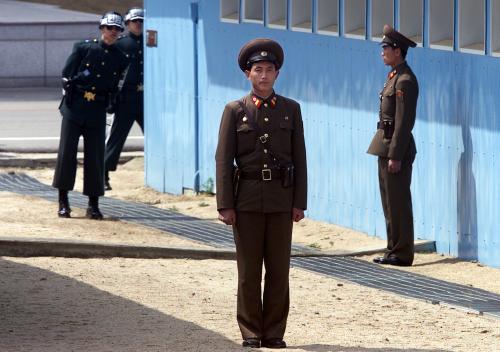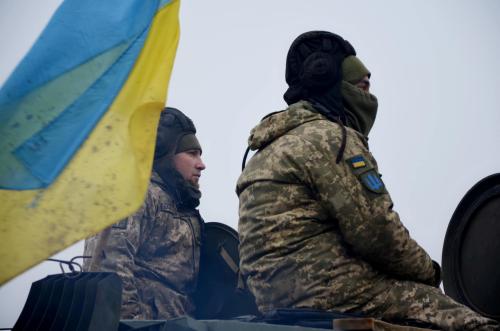Over the last week, the United States and Europe seemed headed for a major split over their approach to Iran’s nuclear program.
Washington argued that a recent report by the International Atomic Energy Agency provided proof positive that Tehran was seeking nuclear weapons in violation of its treaty obligations, and it wanted the matter taken up by the Security Council.
The Europeans, led by Berlin, Paris and London, believed that Tehran’s recent agreement to cooperate with the IAEA by allowing additional inspections and suspending its uranium enrichment program suggested that a cooperative approach—including staying away from the Security Council—should be taken.
A last-minute compromise at the IAEA appears to have solved this short-term conflict, but it should not be mistaken for broad agreement on how best to deal with Iran’s nuclear ambitions. Unless Europe and the United States come together on a long-term strategy for confronting Iran, the conflict will flare up again. Indeed, this dispute still has all the makings of repeating the disastrous fissures that developed over Iraq, except this time Britain is siding with its European partners against the United States. Coming on top of the Iraq debacle, a failure to agree on a common strategy toward Iran could split Europe and the U.S. permanently.
Such a divorce would be tragic for many reasons, not least because in this particular case there is absolutely no difference between the two sides on the ultimate objective. Everyone—Europe and the U.S. as well as Australia, Canada, Japan and even Russia—knows that the consequences of Iran becoming a nuclear power are exceedingly grave.
Tehran’s long-range missiles would put much of Europe within reach of a possible nuclear strike. Neighboring states might respond by acquiring deterrent capabilities of their own. And Israel, which has long seen Iran as a serious threat, might decide to strike preemptively, as it did against Iraq in 1981.
To prevent such a dangerous spiral, Iran’s nuclear weapons development must be halted. For that, it is not enough that Tehran signs on to the Nuclear Nonproliferation Treaty, as it has done. Nor is it sufficient only to allow additional inspections by the IAEA to ascertain that Iran is continuing to abide by its treaty obligations. As long as Iran has the inherent capability to produce nuclear weapons materials, be it by enriching uranium or reprocessing plutonium, Iran will have the option of following in the footsteps of North Korea—declaring it will withdraw from the NPT, ousting the inspectors and putting the finishing touches on a bomb.
Only when the key weapons-material-production parts of the nuclear fuel cycle have been dismantled can there be any confidence that Tehran will not become a nuclear power.
Europeans and Americans agree on the goal of eliminating Iran’s means to produce nuclear weapons. What they don’t agree on is how to get there.
The Bush administration’s strategy appears to be to force Iran to give up its program by confronting it with threats. Having been caught red-handed by the IAEA, which concluded that Iran had engaged in covert enrichment and reprocessing activities for 18 years, the administration believes the time for trust and negotiations is over. The matter should instead be taken up by the Security Council—though Washington is unclear on exactly what actions it would then support.
Europe favors a different tack. Foreign ministers from Britain, France and Germany recently traveled to Tehran and secured Iran’s agreement to suspend its uranium enrichment activities and allow the IAEA to inspect suspected nuclear sites. In return for Iran’s continued cooperation on the issue, the European leaders promised greater economic and technology cooperation, including possibly in the nuclear field, once all concerns had been resolved.
There would seem to be a clear basis for a common strategy—one that goes beyond this week’s U.S.-Europe resolution by combining the Bush administration’s preference for the stick with Europe’s emphasis on carrots.
The U.S. and Europe would have to agree on a clear set of benchmarks to get Iran to give up its enrichment and reprocessing capabilities, with a specific timeline for achieving each of these benchmarks. At the same time, the two sides would have to draw clear lines that Tehran could not cross. Europe and the U.S. would have to reach an understanding of the kinds of sanctions they would impose in the event of noncompliance—from taking the matter up at the U.N. to economic sanctions and, ultimately, to the forceful destruction of facilities.
The high costs of U.S.-European disagreement over how to deal with the threat of weapons of mass destruction are all too obvious. Neither side can afford to repeat the Iraq debacle. In the case of Iran, it should not be beyond the capability of U.S. and European diplomats to forge a common strategy for achieving a common objective—if for once they tried.



Commentary
Op-edA New Strain on Alliance
November 28, 2003